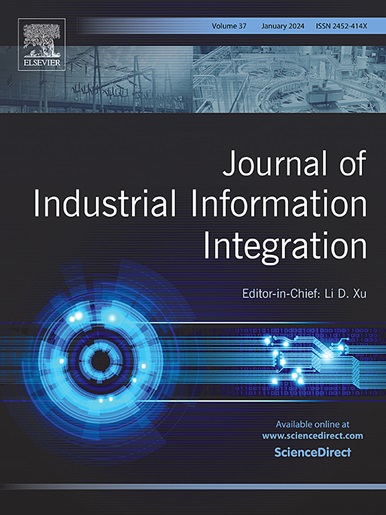基于全景视觉和序列帧相关方法的农用车辆多场景海岬转弯实时路径规划
IF 10.4
1区 计算机科学
Q1 COMPUTER SCIENCE, INTERDISCIPLINARY APPLICATIONS
引用次数: 0
摘要
海岬转弯对基于视觉的农用车辆自主导航提出了重大挑战。与田间作物行跟踪相比,海岬转弯需要更大的转弯角度和更多样化的机动。现有的农用车辆导航研究仅限于使用单个前置摄像头作为传感器。然而,在转向机动时,单个前置视觉传感器的视野受到限制,不可避免地失去对海岬区域的感知。遗憾的是,目前还没有提出一种实用的纯粹基于视觉的海岬转向方法。农业自动化需要强大的工业信息集成工程(IIIE)解决方案,为了解决这一关键差距,本研究开发了包含四个鱼眼相机的全景环绕视图(PSV)系统。生成的PSV图像可以连续感知农用车辆和岬角之间的相对位置。此外,由于感知视点和导航参考的巨大差异,以往在野外检测航标线的方法已不再适用。因此,利用集成的全景数据流,通过提取序列全景帧之间有价值的相关性并集成深度学习技术,开发了一种适合全景视觉的多场景海岬转弯路径规划算法。通过语义分割实现对PSV图像海岬区域的鲁棒检测。通过将相邻框架内的岬角位置相关联,实现了岬角的功能区划定,从而实现了准确的转弯路径规划。利用轻量级模型CGNet,对海岬进行语义分割的平均mIoU达到92.84%。在分辨率为640×340的图像中,检测到的海岬边界的平均偏差为5.63像素。该算法的推理速度为18.45帧/秒。现场导航实验取得了令人满意的结果,表明该方法有效解决了农用车辆仅凭视觉转向的实际挑战,从而为完全基于视觉的IIIE导航系统在农业领域的应用奠定了基础,有助于实现农业产业融合和信息化的更广泛目标。本文章由计算机程序翻译,如有差异,请以英文原文为准。
Real-time path planning for multi-scenario headland turns in agricultural vehicles using panoramic vision and sequential frame correlation method
Headland turning poses a significant challenge to the vision-based autonomous navigation of agricultural vehicles. Compared to in-field crop row tracking, headland turning requires a greater variety of maneuvers with larger turning angles. Existing research on agricultural vehicle navigation is limited to using a single front-facing camera as the sensor. However, during turning maneuvers, the field of view of a single front-facing vision sensor is restricted, inevitably losing perception of the headland area. Unfortunately, no practical purely vision-based headland turning method has been proposed yet. To address this critical gap in agricultural automation, which demands robust industrial information integration engineering (IIIE) solutions, a panoramic surround view (PSV) system incorporating four fisheye cameras was developed in this study. The PSV image generated enabled a continuous perception of the relative position between the agricultural vehicle and the headland. Moreover, due to the vast disparity in perceived viewpoints and navigational references, previous methods for detecting navigational lines in the field are no longer applicable. Therefore, leveraging the integrated panoramic data stream, a multi-scenario headland turning path planning algorithm tailored for panoramic vision has been developed by extracting valuable correlations between sequential panoramic frames and integrating deep learning techniques. Robust detection of the headland area in PSV images was accomplished through semantic segmentation. Functional area delineation of the headland was achieved by correlating the headland locations within adjacent frames, thus enabling accurate turn path planning. Leveraging the lightweight model CGNet, the mean intersection over union (mIoU) for the semantic segmentation of the headland reached 92.84%. The average deviation of the detected headland boundary was 5.63 pixels in an image with a resolution of 640×340. The proposed algorithm demonstrated an inference speed of 18.45 frames per second. Field navigation experiments have yielded promising results, demonstrating that the proposed method effectively addresses the practical challenge of vision-only headland turning for agricultural vehicles, thereby laying the groundwork for a fully vision-based IIIE navigation system in agricultural applications, contributing to the broader goals of industrial integration and informatization in agriculture.
求助全文
通过发布文献求助,成功后即可免费获取论文全文。
去求助
来源期刊

Journal of Industrial Information Integration
Decision Sciences-Information Systems and Management
CiteScore
22.30
自引率
13.40%
发文量
100
期刊介绍:
The Journal of Industrial Information Integration focuses on the industry's transition towards industrial integration and informatization, covering not only hardware and software but also information integration. It serves as a platform for promoting advances in industrial information integration, addressing challenges, issues, and solutions in an interdisciplinary forum for researchers, practitioners, and policy makers.
The Journal of Industrial Information Integration welcomes papers on foundational, technical, and practical aspects of industrial information integration, emphasizing the complex and cross-disciplinary topics that arise in industrial integration. Techniques from mathematical science, computer science, computer engineering, electrical and electronic engineering, manufacturing engineering, and engineering management are crucial in this context.
 求助内容:
求助内容: 应助结果提醒方式:
应助结果提醒方式:


